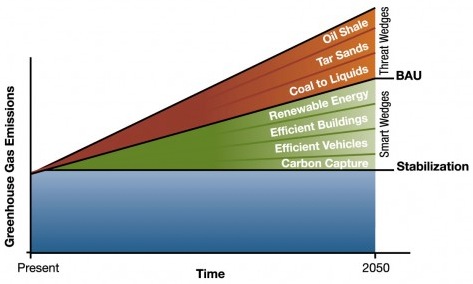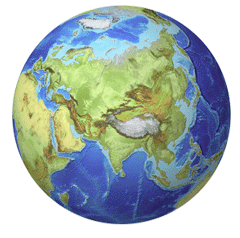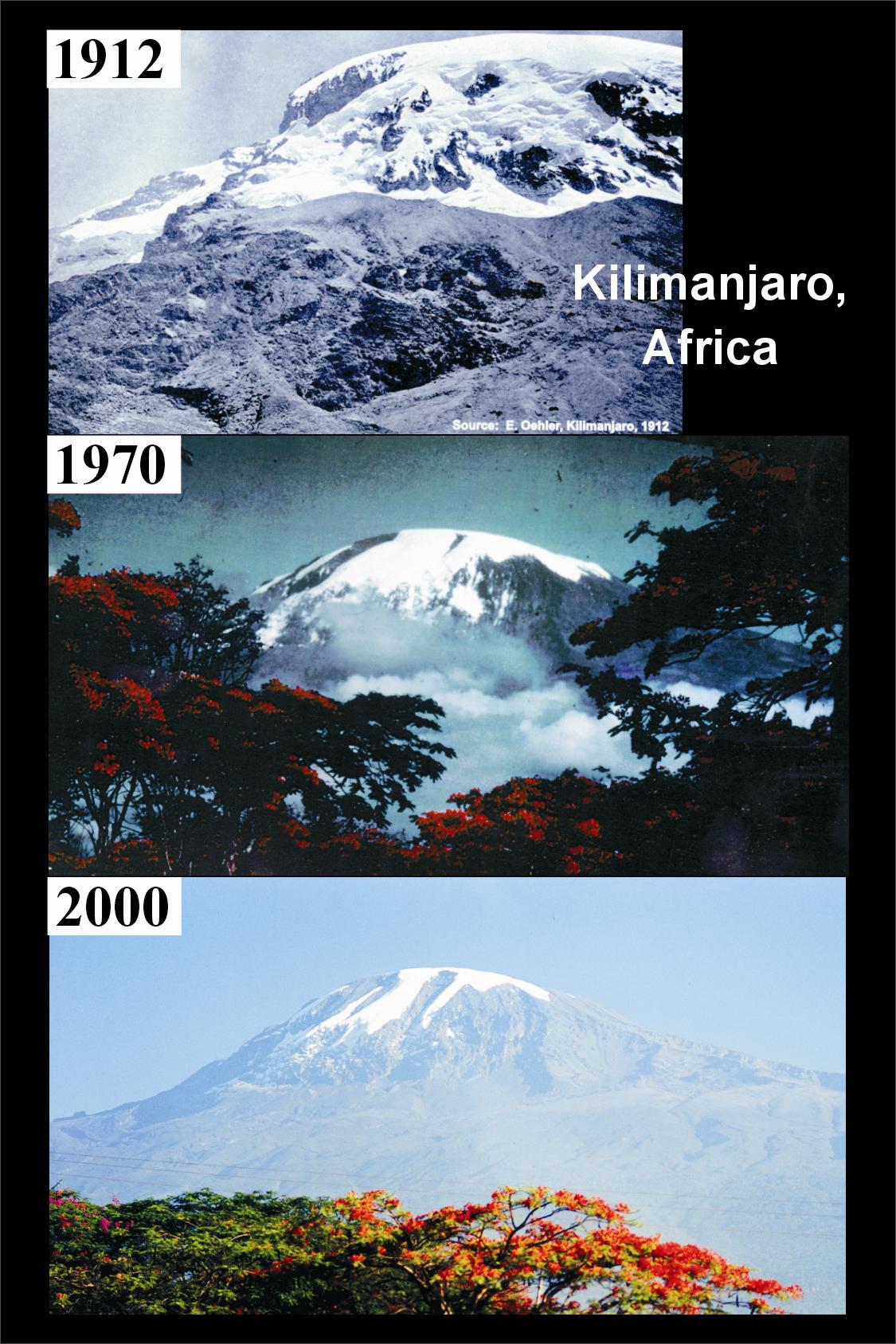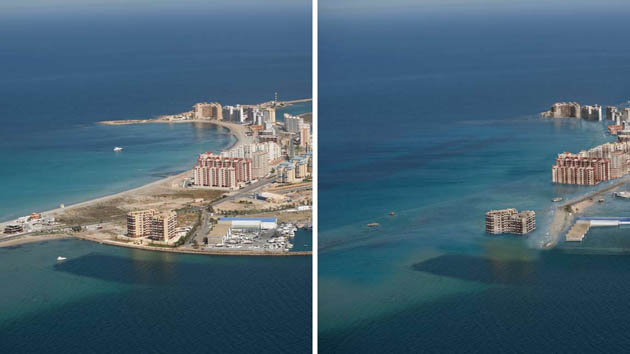13 - Thirteen
Altering
the Global Atmosphere
“…environment altering
abilities did not significantly affect the functioning of the atmospheric system. …Now all that
has changed as human beings have become so dominant a force that we are
significantly modifying the thin layer of gases that envelops the Earth,
changing it so. . . .”
p. 255
Outline
1.
Acid precipitation { 255
2.
Ozone depletion { 258
3.
Climate Change[1]
{ 263
4.
The extent and consequences of global heating {267
a. Greenland Ice Cap crevasse
b. Florida after a six to seven yard rise in sea levels
5.
Dealing with climate change { 280
6.
A Nuclear Atmosphere { 285
7.
Scale, thresholds, non-linearities, and
lags { 286
“complicate and worsen many of the interacting problems we face.”
P. 288.
Images
"The actual amount by which sea level is likely to rise by 2100 remains unclear, but a very conservative estimate would be a foot and a half (50 centimeter) with further rises continuing over the next several centuries. "
(p. 271)
"The increase was caused by the injection into the atmosphere of nitrogen oxides (NOx) and sulfur dioxide SO2) principally by automobile exhausts and power plants that burn fossil fuels."
p.255-256.
The term "waldsterben" is German for forest destruction.
Coal for electricity from midwestern power plants, longa source of mercury, sulfur and carbon dioxide pollution destroyed streams, forests, and fisheries in neighboring Pennsylvania, New York, Canada, and New England because a technical solution called "very tall stacks" dispersed emissions away fro nthe site of the power plants and aloft into the upper atmosphere.
The seriousness of cross-boundary pollution of air and water sources was a wake-up call, initially denied by industry and government with timber and agriculture paying the price in diminished forest growth, crops and orchards.
Ozone depletion due to Freon gas or CFCs
Rowland and Molina
"UV radiation breaks down ozone (O3), in a continuing cycle that normally maintains a steady concentration of ozone."
p. 259.
"There is a cautionary tale about technology here: when we pull technological rabbits out of the hat. . . .but a deep plunge during the 1980-1982 still had not been detected by analysts."
p. 260.
"Their work helped save humanity from untold misery, and at the same time they revealed a story of unintended consequences that should be engraved in the memories of those who think technology will solve all human problems."
p. 261.
"The climate change we now face is the inadvertent result of human actions. In the minds of many, if not most, global heating is the single most critical environmental threat to civilization.... global heating almost certainly poses and array of gigantic problems."
pp. 263-264.
Two ways
1) land-use changes altering the reflectivity of the surface
2) adding greenhouse gases to the atmosphere.
"While CO2 is projected to account for about 70 percent of the human induced anthropogenic warming over the next century, methane will produce almost 20 percent and nitrous oxide almost 10 percent...."
p. 266.
"The extent and consequences of global heating
"determination of both the climate and social consequences of the inevitable further loading o of the atmosphere with greenhouse gases in the coming decades." is difficult.
"Global heating effects will also be depend heavily on the balance of little-known feedback mechanisms....Such feedbacks would be destabilizing and would further increase the temperature rise caused by the original warming."
A) melting of tundra and the rotting of tundra vegetation releasing methane.
B) is the creation of high-level clouds which would trap surface heat.
"upward creep of oceans is caused by the expansion that water undergoes when heated...."
"...that the Greenland ice sheet could melt off in the next thousand years. That alone would raise sea level about 22 feet (or seven meters), an extraordinary amount.
Dealing with climate change
p. 280.
"There is no straightforward answer to that insurance question, but plenty of debate."
"Shows that a portfolio of technologies already in hand and more or less practical to deploy could be used to keep the atmospheric CO2 concentration under 500 ppm."
p. 280.
Wedges

"increasing energy efficiency is the most effective measure that can be taken promptly–the easiest, fastest, and cheapest way to reduce energy-based greenhouse gas emissions."
"Both carbon taxes and cap-and-trade arrangements are called incentive-based approaches because they raise the cost of emissions, which gives polluters incentives to find ways to cut their emissions."
p. 282.
Scale, Thresholds, Non-linearities and Lags
the size of San Francisco from 1848-1948-2008 –"a typical problem of scale."
"Problems connected to the scale of human population or its practices also may contain threshold factors–a sudden transition from one environmental state to another, when scale problems go over a brink."
"Climate is an example of a non-linear system, one in which a steady rise in an input does not necessarily result in a steady rate of change but instead may cause a slow response at first, which then accelerates as the input rises "
p. 287
“Maintaining populations, species and
ecosystems in the face of those changes, and maintaining the flow of the goods
and services they provide humanity, will require active management in the
foreseeable future.”
p. 289
Vocabulary
Rates,
change over time,
air refraction,
reflection,
irradiance,
scale,
inverse relations,
adiabatic lapse rate,
differentials,
dose response,
threshold,
lag
Sources on line
http://climatedenial.org/2010/12/02/one-report-two-headlines/
Adaptation: http://www.cakex.org/
Facts and figures: http://www.realclimate.org/



